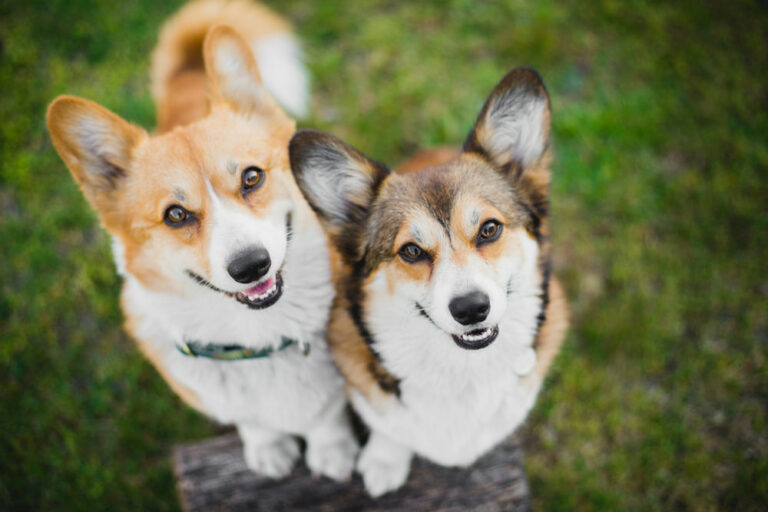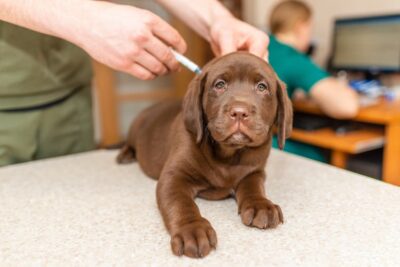How to Introduce Dogs: Tips to Follow

If you’re considering bringing home a second dog, you’re not alone. According to Best Friends Animal Society, a whopping 29 percent of American households are multi-pet, and for good reason. Giving your resident dog a buddy has benefits like providing a sibling that’s a built-in playmate and giving one another companionship when you’re not home.
But figuring out how to introduce dogs without problems requires a thorough plan and household management techniques put in place before your new dog arrives. Here’s how to make introductory meetings go smoothly.
How To Introduce Dogs to Each Other

If you are looking to introduce your resident pup to a new canine companion, it’s important to follow some key guidelines. When learning how to introduce dogs to each other, try these steps.
Find a Co-Handler
The first step in learning how to introduce two dogs is finding a competent co-handler who understands canine body language. Since dog interactions are often subtle and can escalate quickly, it’s important that both parties understand the nuances of canine body language and are comfortable taking the steps necessary to keep all parties safe, like moving away before the dogs become aroused or agitated.
Let Dogs Meet on Neutral Ground
The next important consideration when working on introducing dogs to each other is securing a neutral, outdoor fenced space like a friend’s yard or a fenced park. This puts both dogs on a level playing field instead of giving your resident dog the literal home-team advantage in her own yard.
Make Sure Both Dogs Are Leashed
During the early stages of an introduction, both dogs should be on a fixed-length, 6-foot leash. Do not attempt an introduction on a flexible leash, as an accidental tangle or fur-burn can escalate tensions.
Keep the Distance—At First
Begin with both dogs far enough apart in the fenced space. They should be aware of one another but still able to focus on and investigate the area around them. This distance varies, but a safe starting point is at least 20 feet apart.
Walk the dogs parallel to each other, allowing them to sniff and eliminate as you stroll, then switch positions with the other handler so you’re each walking a dog where the other dog walked prior. This type of scenting allows the dogs to pick up more information about each other.
Pay Close Attention to Signals
Look for the dogs to be interested in one another and displaying loose, waggy body language. Tense posture, a high, stiff tail, freezing in place, or hard stares are possible warning signs that the interaction needs to slow down. More demonstrative behaviors, like lunging and hard barking, suggest that the introduction should be called off before the dogs get closer. It is OK to stop the session and try again in 20 minutes. Going extra slow is always OK. Pushing uncomfortable dogs together can ruin your chances of ever having a successful meeting.
Close the Gap Between Dogs
If both dogs are displaying social behaviors and seem happily interested in interacting, gradually decrease the space between them as you and your partner parallel walk. Be careful to avoid face-to-face encounters as you get closer, since a head-on approach can escalate tensions, particularly with dogs on leash.
Drop the Leashes
When both dogs are displaying appropriate and interested behavior and both handlers are comfortable with what they’re seeing, you can drop the leashes. Make sure you are in a safe place to do so!
At this point you should see mutual circling and sniffing and other ritualistic greeting behaviors. Calmly praise the dogs as they get to know one another. It’s likely that a gradual positive introduction will lead to the universal invitation to play; elbows on the ground and rear in the air. And then the fun begins!
Keep the First Play Session Short
Even though dog play can be energetic and loud, make sure that both dogs are respecting the other’s signals. That means you should see give and take during play as well as short breaks in the action.
Although it’s tempting to let the new friends play until they’re exhausted, it’s better to allow for a brief session then end with a short walk together. Meeting other dogs can be fun and stressful, so rather than letting the interaction tip over into potentially inappropriate behavior, it’s best to end on a positive note.
Introducing a Puppy to Your Resident Dog

Because most puppies are eager to greet the whole world with a wag, an introduction between a resident dog and a new puppy is usually less challenging than introducing two adult dogs.
That said, it’s not always love at first sight between your dog and an overexcited pup, especially if the puppy is larger than your resident dog, or your resident dog is older and might be worried about potential pain caused by youthful silliness.
Puppies haven’t learned how to “dog” yet which means they usually don’t understand proper greeting protocols, but a well-socialized adult dog will likely roll with most of the mischief served up by a puppy. That said, it’s within an adult dog’s rights to instruct an impolite puppy with a snarl, bark, or in some cases even a quick pinning if the puppy comes on too strong. As long as the adult dog backs off quickly after the correction and the puppy seems unphased by it, the interaction can continue. If the puppy continues pushing the resident dog despite appropriate corrections, take a break and redirect the puppy with play.
It can take time before an older dog is comfortable with a new, younger sibling, but giving your resident dog solo time away from the puppy, either with you or alone with a tasty distraction, will help to ease the transition.
Red Flags During an Introduction

Sometimes, despite your best efforts, things go poorly during an introduction between two dogs. Unfortunately, not all of the potential red flags are always easy to spot, but some of the more obvious signs include:
- Hard barking
- Direct stare without looking away
- Complete disinterest in each other or avoidance
- Intense play without breaks, even when one dog tries to stop
- Yawning, lip licking, frequent shaking off
If either your resident dog or the potential new dog exhibit concerning behaviors during the introduction stages, consider calling it off and try again another day to see if things go differently.
If you’re unsure about the feedback your dog is offering, reach out to a qualified dog trainer or behaviorist for support.
Introducing a New Dog Into Your Home: The Basics
It’s important to do a safety sweep before your new dog arrives home, even if the newbie is an adult. Keep in mind that even house-trained adult dogs can have accidents or destructive chewing regressions in a new environment, so the key is to set your new dog up for success.
First, pick up anything that might be a temptation for chewing, like shoes, laundry, or an easily accessible garage pan or litter box. Consider closing off rooms that are challenging to dog proof and invest in doorway gates to cordon off specific areas. Prepare to manage your dog’s environment by preventing him from sneaking off into other rooms, either to chew or potty.
Your resident dog’s toys and chews might cause scuffles over ownership as your new pup settles in, so pick up all goodies during the acclimation period. Make sure that each dog has their own food and water bowls that aren’t directly next to each other.
Creating a Safe Space
Even though moving into a new home is a joyful experience, particularly for dogs coming out of the shelter system, new-to-you dogs need space and time to acclimate to their environment.
It helps to provide a go-to spot where your dog can curl up and relax that’s away from the hubbub but close enough that she doesn’t feel left out. A crate is a good option for dogs already comfortable using one, or a cozy bolster-style bed that’s tucked away in a corner.
Family members, both canine and human, should respect when the new dog needs a break, but be aware that in certain scenarios it’s helpful to require brief time-outs, since some dogs have a tough time settling down.
Keep the household low key and guests to a minimum during the early few weeks of a new dog’s acclimation period. The full adjustment period can last as long as a few months, so be aware that highs and lows can be expected as your new dog settles in.
Preserving Peace In The Home

Since moving from a one-dog household to one with two dogs can mean upheaval for the resident dog, try to stick to a familiar schedule for feeding, walks, and play. If possible, spend time alone with each dog during the first few weeks.
Even if the new siblings are getting along beautifully it’s important to separate them when you leave the house, as well as when you’re in the house and otherwise engaged, like in the shower.
It’s always best to prevent simmering tensions from escalating rather than trying to redirect them after they’ve begun, so watch out for any subtle signs of discomfort between your dogs. These signals may include body blocks in doorways or around you (meaning, one dog positions itself so that something or someone is inaccessible to the other), low growling, and freezing or staring, particularly around resources like resting spots or food bowls.
Finally, don’t forget to give your dogs occasional timeouts apart from one another. Even if they’re having a wonderful time playing together, sometimes dogs aren’t capable of taking a break from the action without assistance. Giving them each something to do in separate areas, like a bone or treat-stuffed busy toy, will prevent accidental escalations and help them settle down.
In time and with your support, the new siblings will find their groove together and you’ll be lucky enough to watch their friendship blossom!









